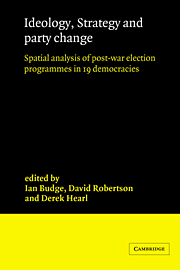 Ideology, Strategy and Party Change
Ideology, Strategy and Party Change Book contents
- Frontmatter
- Contents
- List of Tables
- List of Figures
- Preface
- 1 The influence of election programmes: Britain and Canada 1945–1979.
- 2 The internal analysis of election programmes.
- 3 Britain, Australia, New Zealand and the United States 1946–1981, an initial comparative analysis.
- 4 Canada 1945–1980: party platforms and campaign strategies.
- 5 Sri Lanka 1947–1977: elite programmes and mass politics.
- 6 Israel 1949–1981.
- 7 Ireland 1948–1981: issues, parties, strategies.
- 8 Northern Ireland 1921–1973: party manifestos and platforms.
- 9 Sweden and Denmark 1945–1982: election programmes in the Scandinavian setting.
- 10 The Netherlands 1946–1981.
- 11 Belgium 1946–1981.
- 12 Luxembourg 1945–1982: dimensions and strategies.
- 13 Austria 1945–1978.
- 14 Electoral programmes in West Germany 1949–1980: explorations in the nature of political controversy.
- 15 France 1958–1981: the strategy of joint government platforms.
- 16 Italy 1946–1979: ideological distances and party movements.
- 17 Japan 1960–1980: party programmes in elections.
- 18 Do parties differ, and how? Comparative discriminant and factor analyses.
- Appendices
- General bibliography
- Index
9 - Sweden and Denmark 1945–1982: election programmes in the Scandinavian setting.
Published online by Cambridge University Press: 27 October 2009
- Frontmatter
- Contents
- List of Tables
- List of Figures
- Preface
- 1 The influence of election programmes: Britain and Canada 1945–1979.
- 2 The internal analysis of election programmes.
- 3 Britain, Australia, New Zealand and the United States 1946–1981, an initial comparative analysis.
- 4 Canada 1945–1980: party platforms and campaign strategies.
- 5 Sri Lanka 1947–1977: elite programmes and mass politics.
- 6 Israel 1949–1981.
- 7 Ireland 1948–1981: issues, parties, strategies.
- 8 Northern Ireland 1921–1973: party manifestos and platforms.
- 9 Sweden and Denmark 1945–1982: election programmes in the Scandinavian setting.
- 10 The Netherlands 1946–1981.
- 11 Belgium 1946–1981.
- 12 Luxembourg 1945–1982: dimensions and strategies.
- 13 Austria 1945–1978.
- 14 Electoral programmes in West Germany 1949–1980: explorations in the nature of political controversy.
- 15 France 1958–1981: the strategy of joint government platforms.
- 16 Italy 1946–1979: ideological distances and party movements.
- 17 Japan 1960–1980: party programmes in elections.
- 18 Do parties differ, and how? Comparative discriminant and factor analyses.
- Appendices
- General bibliography
- Index
Summary
THE PARTY SYSTEMS
Here, as in Chapter 3, we analyse culturally related countries together – partly because the discussion can be presented more succinctly, but also because divergences stemming from different institutional structures (particularly from contrasting party systems) can be highlighted in an interesting way.
Sweden has a predominant party system overshadowed by the Social Democrats, who obtained 40–50 per cent of the votes from the 1930s, and governed from 1932–76, though occasionally in coalition. Their predominance was in part secured through the fragmentation of the opposition between the Conservatives – a fairly standard business-oriented group, strongest in the South; the Liberals – radical in European terms, with advanced libertarian and welfare positions; the Agrarians – traditionally non-conformist in religion, teetotaller in ideology and supportive of rural interests; and the Communists.
This five-party system emerged in Sweden from 1900–20 and has remained structurally unchanged from that date, in contrast to Denmark. However, relationships within and between the parties underwent substantial changes during the 1960s and 1970s. The Agrarian Party, responding to the decline of the rural population, changed its name to the Centre Party and very successfully extended its appeal to radical, free-thinking voters in the city on ‘new’ issues such as the environment. At the same time moves were made to commit the bourgeois parties to an electoral alliance against the Social Democrats, as it was obvious that no credible governmental alternative could emerge short of a coalition including all three.
- Type
- Chapter
- Information
- Ideology, Strategy and Party ChangeSpatial Analyses of Post-War Election Programmes in 19 Democracies, pp. 177 - 206Publisher: Cambridge University PressPrint publication year: 1987
- 1
- Cited by


